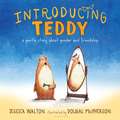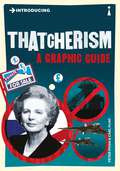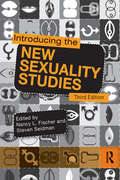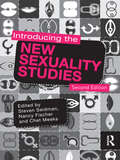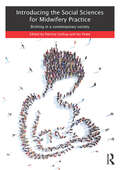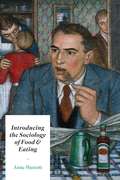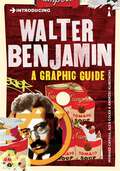- Table View
- List View
Introducing Social Work (Transforming Social Work Practice Series)
This practical guide will help students navigate through all core areas of their course by providing them with a comprehensive introduction to contemporary social work. Written by subject experts, including best-selling Transforming Social Work Practice authors, this essential guide will introduce students to key theory and approaches, helping them to develop and build the skills and knowledge that they will need for practice.
Introducing Social Work (Transforming Social Work Practice Series)
Everything you need to succeed in your social work degree! Written by subject experts, this essential guide will introduce you to all the core areas of your course, helping you develop the knowledge and skills you need to practice with confidence. Since launching in 2003, Transforming Social Work Practice has become the market-leading series for social work students. These books use activities and case studies to build critical thinking and reflection skills and will help social work students to develop good practice through learning. These books are: · Affordable · Written to the Professional Capabilities Framework · Mapped to the social work curriculum · Practical with clear links between theory and practice
Introducing Survival and Event History Analysis
by Melinda MillsIntroducing Survival Analysis and Event History Analysis is an accessible, practical and comprehensive guide for researchers and students who want to understand the basics of survival and event history analysis and apply these methods without getting entangled in mathematical and theoretical technicalities. Inside, readers are offered a blueprint for their entire research project from data preparation to model selection and diagnostics. Engaging, easy to read, functional and packed with enlightening examples, 'hands-on' exercises and resources for both students and instructors, Introducing Survival Analysis and Event History Analysis allows researchers to quickly master these advanced statistical techniques. This book is written from the perspective of the 'user', making it suitable as both a self-learning tool and graduate-level textbook. Introducing Survival Analysis and Event History Analysis covers the most up-to-date innovations in the field, including advancements in the assessment of model fit, frailty and recurrent event models, discrete-time methods, competing and multistate models and sequence analysis. Practical instructions are also included, focusing on the statistical program R and Stata, enabling readers to replicate the examples described in the text. This book comes with a glossary, a range of practical and user-friendly examples, cases and exercises, and is accompanied by a wide range of supportive materials to download at the companion website, including the example data sets and programming files, plus study and teaching material.
Introducing Survival and Event History Analysis
by Melinda MillsIntroducing Survival Analysis and Event History Analysis is an accessible, practical and comprehensive guide for researchers and students who want to understand the basics of survival and event history analysis and apply these methods without getting entangled in mathematical and theoretical technicalities. Inside, readers are offered a blueprint for their entire research project from data preparation to model selection and diagnostics. Engaging, easy to read, functional and packed with enlightening examples, 'hands-on' exercises and resources for both students and instructors, Introducing Survival Analysis and Event History Analysis allows researchers to quickly master these advanced statistical techniques. This book is written from the perspective of the 'user', making it suitable as both a self-learning tool and graduate-level textbook. Introducing Survival Analysis and Event History Analysis covers the most up-to-date innovations in the field, including advancements in the assessment of model fit, frailty and recurrent event models, discrete-time methods, competing and multistate models and sequence analysis. Practical instructions are also included, focusing on the statistical program R and Stata, enabling readers to replicate the examples described in the text. This book comes with a glossary, a range of practical and user-friendly examples, cases and exercises, and is accompanied by a wide range of supportive materials to download at the companion website, including the example data sets and programming files, plus study and teaching material.
Introducing Teddy: A gentle story about gender and friendship
by Jessica WaltonIntroducing Teddy introduces the youngest readers to understanding gender identity and transition in an accessible and heart-warming story about being true to yourself and being a good friend.Errol and his teddy, Thomas, are best friends who do everything together. Whether it's riding a bike, playing in the tree house, having a tea party, or all of the above, every day holds something fun to do. One sunny day, Errol finds that Thomas is sad, even when they are playing in their favorite ways. Errol can't figure out why, until Thomas finally tells Errol what the teddy has been afraid to say: "In my heart, I've always known that I'm a girl teddy, not a boy teddy. I wish my name was Tilly, not Thomas." And Errol says, "I don't care if you're a girl teddy or a boy teddy! What matters is that you are my friend."
Introducing Teddy: A gentle story about gender and friendship
by Jessica Walton Dougal MacPhersonIntroducing Teddy introduces the youngest readers to understanding gender identity and transition in an accessible and heart-warming story about being true to yourself and being a good friend.Errol and his teddy, Thomas, are best friends who do everything together. Whether it's riding a bike, playing in the tree house, having a tea party, or all of the above, every day holds something fun to do. One sunny day, Errol finds that Thomas is sad, even when they are playing in their favorite ways. Errol can't figure out why, until Thomas finally tells Errol what the teddy has been afraid to say: "In my heart, I've always known that I'm a girl teddy, not a boy teddy. I wish my name was Tilly, not Thomas." And Errol says, "I don't care if you're a girl teddy or a boy teddy! What matters is that you are my friend."
Introducing Thatcherism: A Graphic Guide (Introducing...)
by Peter PughMargaret Thatcher's political career was one of the most remarkable of modern times. She rose to become the first woman to lead a major Western democracy, serving as British Prime Minister. Admired by Ronald Regan and the United States Congress, "Introducing Thatcherism" looks at the political philosophy behind this influential and controversial woman.
Introducing the Creative Industries: From Theory to Practice
by Gauti Sigthorsson Rosamund Davies"This text does a sterling job at identifying, outlining and defining the many elements that go to make up this booming sector of industry. What makes it particularly interesting is that it includes the view of the creative industries from the perspective of working in it, then the definitions of what products and producers are involved, and ends with the broader picture of the creative economy and predictions for future trends. Add to this that they include both theory and practice, and this really is an all-round guide to the vast domain that is loosely titled 'the creative industries'" - Angela Birchall, School of Media, Music & Performance, Salford University This is your complete guide to studying and succeeding in the creative industries. This book takes you through the history, trends, products and markets of the creative industries, showing how success depends on a mix of ideas, tactics and talent. When understanding social networks and cultural economy is just as important as hands-on skills or an entrepreneurial spirit, Introducing the Creative Industries shows you how to use theories, concepts and practical skills to get ahead in their course and professional life. Creatively imagined and beautifully written, this book: Interweaves theoretical concepts and professional practice on every page Uses cultural economy to teach the essential concepts and thinkers Integrates case studies from fashion and gaming to journalism and music Teaches strategies for navigating the links between skills, industries, creativity and markets. This book shows you how to spot opportunities and use your knowledge and savvy to take kickstart your career in this fast-moving industry. It is an essential guidebook for students of creativity in media and communication, design, creative industries and business.
Introducing the Creative Industries: From Theory to Practice
by Gauti Sigthorsson Rosamund Davies"This text does a sterling job at identifying, outlining and defining the many elements that go to make up this booming sector of industry. What makes it particularly interesting is that it includes the view of the creative industries from the perspective of working in it, then the definitions of what products and producers are involved, and ends with the broader picture of the creative economy and predictions for future trends. Add to this that they include both theory and practice, and this really is an all-round guide to the vast domain that is loosely titled 'the creative industries'" - Angela Birchall, School of Media, Music & Performance, Salford University This is your complete guide to studying and succeeding in the creative industries. This book takes you through the history, trends, products and markets of the creative industries, showing how success depends on a mix of ideas, tactics and talent. When understanding social networks and cultural economy is just as important as hands-on skills or an entrepreneurial spirit, Introducing the Creative Industries shows you how to use theories, concepts and practical skills to get ahead in their course and professional life. Creatively imagined and beautifully written, this book: Interweaves theoretical concepts and professional practice on every page Uses cultural economy to teach the essential concepts and thinkers Integrates case studies from fashion and gaming to journalism and music Teaches strategies for navigating the links between skills, industries, creativity and markets. This book shows you how to spot opportunities and use your knowledge and savvy to take kickstart your career in this fast-moving industry. It is an essential guidebook for students of creativity in media and communication, design, creative industries and business.
Introducing the New Sexuality Studies: Original Essays
by Nancy L. Fischer Laurel Westbrook Steven SeidmanIntroducing the New Sexuality Studies: Original Essays is an innovative, reader-friendly collection of essays that introduces the field of sexuality studies to undergraduate students. Examining the social, cultural, and historical dimensions of sexuality, this collection is designed to serve as a comprehensive yet accessible textbook for sexuality courses at the undergraduate level. The fourth edition adds 51 new essays whilst retaining 33 of the most popular essays from previous editions. It features perspectives that are intersectional, transnational, sex positive, and attentive to historically marginalized groups along multiple axes of inequality, including gender, race, class, ability, body size, religious identity, age, and, of course, sexuality. Essays explore how a wide variety of social institutions, including medicine, religion, the state, and education, shape sexual desires, behaviors, and identities. Sources of, and empirical research on, oppression are discussed, along with modes of resistance, activism, and policy change. The fourth edition also adds new user-friendly features for students and instructors. Keywords are italicized and defined, and each chapter concludes with review questions to help students ascertain their comprehension of key points. There is also an online annotated table of contents to help readers identify key ideas and concepts at a glance for each chapter.
Introducing the New Sexuality Studies: Original Essays
by Nancy L. Fischer Laurel Westbrook Steven SeidmanIntroducing the New Sexuality Studies: Original Essays is an innovative, reader-friendly collection of essays that introduces the field of sexuality studies to undergraduate students. Examining the social, cultural, and historical dimensions of sexuality, this collection is designed to serve as a comprehensive yet accessible textbook for sexuality courses at the undergraduate level. The fourth edition adds 51 new essays whilst retaining 33 of the most popular essays from previous editions. It features perspectives that are intersectional, transnational, sex positive, and attentive to historically marginalized groups along multiple axes of inequality, including gender, race, class, ability, body size, religious identity, age, and, of course, sexuality. Essays explore how a wide variety of social institutions, including medicine, religion, the state, and education, shape sexual desires, behaviors, and identities. Sources of, and empirical research on, oppression are discussed, along with modes of resistance, activism, and policy change. The fourth edition also adds new user-friendly features for students and instructors. Keywords are italicized and defined, and each chapter concludes with review questions to help students ascertain their comprehension of key points. There is also an online annotated table of contents to help readers identify key ideas and concepts at a glance for each chapter.
Introducing the New Sexuality Studies: 3rd Edition
by Steven Seidman Nancy L. FischerIntroducing the New Sexuality Studies is an innovative, reader-friendly anthology of original essays and interviews that introduces the field of sexuality studies to undergraduate students. Examining the social, cultural, and historical dimensions of sexualities, this anthology is designed to serve as a comprehensive textbook for sexualities and gender-related courses at the undergraduate level. The book’s contributors include both well-established scholars, including Patricia Hill Collins, Jeffrey Weeks, Deborah L. Tolman, and C.J. Pascoe, as well as emerging voices in sexuality studies. This collection will provide students of sociology, gender, and sexuality with a challenging and broad introduction to the social study of sexuality that they will find accessible and engaging.
Introducing the New Sexuality Studies: 3rd Edition
by Steven Seidman Nancy L. FischerIntroducing the New Sexuality Studies is an innovative, reader-friendly anthology of original essays and interviews that introduces the field of sexuality studies to undergraduate students. Examining the social, cultural, and historical dimensions of sexualities, this anthology is designed to serve as a comprehensive textbook for sexualities and gender-related courses at the undergraduate level. The book’s contributors include both well-established scholars, including Patricia Hill Collins, Jeffrey Weeks, Deborah L. Tolman, and C.J. Pascoe, as well as emerging voices in sexuality studies. This collection will provide students of sociology, gender, and sexuality with a challenging and broad introduction to the social study of sexuality that they will find accessible and engaging.
Introducing the New Sexuality Studies: 2nd Edition
by Steven Seidman Nancy L. Fischer Chet MeeksBreaking new ground, both substantively and stylistically, Introducing the New Sexuality Studies, Second Edition offers students and academics an engaging, thought-provoking introduction and overview of the social study of sexualities. Its central premise is to explore the social construction of sexuality, the role of social differences such as race or nationality in creating sexual variation, and the ways sex is entangled in relations of power and inequality. Through this approach the field of sexuality is considered in multicultural, global, and comparative terms, and from a truly social perspective. The second edition of this definitive textbook consists of over seventy-five short, original essays on the key topics and themes in sexuality studies. It also includes interviews with fourteen leading scholars in the field, which convey some of the most innovative work currently being undertaken. Each contribution is original, presenting the latest thinking and research in clear and accessible terms, using engaging examples to illustrate key points. This topical and timely volume will be an invaluable resource to all those with an interest in sexuality studies, gender studies and LGBTQ studies.
Introducing the New Sexuality Studies: 2nd Edition
by Steven Seidman Nancy L. Fischer Chet MeeksBreaking new ground, both substantively and stylistically, Introducing the New Sexuality Studies, Second Edition offers students and academics an engaging, thought-provoking introduction and overview of the social study of sexualities. Its central premise is to explore the social construction of sexuality, the role of social differences such as race or nationality in creating sexual variation, and the ways sex is entangled in relations of power and inequality. Through this approach the field of sexuality is considered in multicultural, global, and comparative terms, and from a truly social perspective. The second edition of this definitive textbook consists of over seventy-five short, original essays on the key topics and themes in sexuality studies. It also includes interviews with fourteen leading scholars in the field, which convey some of the most innovative work currently being undertaken. Each contribution is original, presenting the latest thinking and research in clear and accessible terms, using engaging examples to illustrate key points. This topical and timely volume will be an invaluable resource to all those with an interest in sexuality studies, gender studies and LGBTQ studies.
Introducing the Social Sciences for Midwifery Practice: Birthing in a Contemporary Society
by Ian Peate Patricia LindsayIntroducing the Social Sciences for Midwifery Practice makes clear the links between social, anthropological and psychological concepts, midwifery practice and women’s experience of birth. Demonstrating how empathising with women and understanding the context in which they live can affect childbirth outcomes and experiences, this evidence-based text emphasises the importance of compassionate and humane care in midwifery practice. Exploring midwifery as an art, as well as a science, the authors collected here make the case for midwives as professionals working ‘with women’ rather than as birth technicians, taking a purely competency-based approach to practice. The book incorporates a range of pedagogical features to enhance student learning, including overall chapter aims and learning outcomes, ‘recommendations for practice’, ‘learning triggers’ to encourage the reader to delve deeper and reflect on practice, ‘application to practice’ case studies which ensure that the theory is related to contemporary practice, and a glossary of terms. The chapters cover perspectives on birth from sociology; psychology; anthropology; law; social policy and politics. Other chapters address important issues such as disability, politics and sexuality. Outlining relevant theory from the social sciences and clearly applying it to practice, this text is an essential read for all student midwives, registered midwives and doulas. ?
Introducing the Social Sciences for Midwifery Practice: Birthing in a Contemporary Society
by Ian Peate Patricia LindsayIntroducing the Social Sciences for Midwifery Practice makes clear the links between social, anthropological and psychological concepts, midwifery practice and women’s experience of birth. Demonstrating how empathising with women and understanding the context in which they live can affect childbirth outcomes and experiences, this evidence-based text emphasises the importance of compassionate and humane care in midwifery practice. Exploring midwifery as an art, as well as a science, the authors collected here make the case for midwives as professionals working ‘with women’ rather than as birth technicians, taking a purely competency-based approach to practice. The book incorporates a range of pedagogical features to enhance student learning, including overall chapter aims and learning outcomes, ‘recommendations for practice’, ‘learning triggers’ to encourage the reader to delve deeper and reflect on practice, ‘application to practice’ case studies which ensure that the theory is related to contemporary practice, and a glossary of terms. The chapters cover perspectives on birth from sociology; psychology; anthropology; law; social policy and politics. Other chapters address important issues such as disability, politics and sexuality. Outlining relevant theory from the social sciences and clearly applying it to practice, this text is an essential read for all student midwives, registered midwives and doulas. ?
Introducing the Sociology of Food and Eating
by Anne MurcottThis textbook equips students with the ability to analyze and think critically about contemporary food topics. A thorough introduction to the sociology of food and eating, the book also acts as a primer to the discipline of sociology more generally. Chapters start with a 'common sense' assumption about food which students frequently encounter in their own lives or in the mass media. Topics include family meals, ethnic cuisines, cooking skills and convenience foods, eating out, food waste, and 'overpackaging'. Anne Murcott shows how systematic academic research approaches can allow students to move beyond 'conventional wisdoms' to examine sociological perspectives on food and eating. Key sociological concerns such as class, gender, age, ethnicity, power and identity are also introduced, accompanied by a wide range of examples from around the globe. By the end, readers will be able to think more critically and to apply sociological approaches to questions about food and society. Introducing the Sociology of Food and Eating is an essential introductory textbook for students in sociology and food studies. It provides readers with a solid basis for success in their studies - and with a new understanding of their own attitudes to food and eating.
Introducing the Sociology of Food and Eating
by Anne MurcottThis textbook equips students with the ability to analyze and think critically about contemporary food topics. A thorough introduction to the sociology of food and eating, the book also acts as a primer to the discipline of sociology more generally. Chapters start with a 'common sense' assumption about food which students frequently encounter in their own lives or in the mass media. Topics include family meals, ethnic cuisines, cooking skills and convenience foods, eating out, food waste, and 'overpackaging'. Anne Murcott shows how systematic academic research approaches can allow students to move beyond 'conventional wisdoms' to examine sociological perspectives on food and eating. Key sociological concerns such as class, gender, age, ethnicity, power and identity are also introduced, accompanied by a wide range of examples from around the globe. By the end, readers will be able to think more critically and to apply sociological approaches to questions about food and society. Introducing the Sociology of Food and Eating is an essential introductory textbook for students in sociology and food studies. It provides readers with a solid basis for success in their studies - and with a new understanding of their own attitudes to food and eating.
Introducing Urban Anthropology
by Rivke Jaffe Anouk de KoningThis book provides an up-to-date introduction to the important field of urban anthropology. This is a critical area of study, as more than half of the world’s population now lives in cities and anthropological research is increasingly done in an urban context. Exploring contemporary anthropological approaches to the urban, the authors consider: How can we define urban anthropology? What are the main themes of twenty-first-century urban anthropological research? What are the possible future directions in the field? The chapters cover topics such as urban mobilities, place-making and public space, production and consumption, and politics and governance. These are illustrated by lively case studies drawn from urban settings across the world. Accessible yet theoretically incisive, Introducing Urban Anthropology will be a valuable resource for anthropology students and also for those working in urban studies and related disciplines such as sociology and geography. The revised second edition includes updated theoretical discussions and new ethnographic case studies. It features a new chapter on neoliberalism, austerity and solidarity, and engages more extensively with digital transformations of urban life.
Introducing Urban Anthropology
by Rivke Jaffe Anouk de KoningThis book provides an up-to-date introduction to the important field of urban anthropology. This is a critical area of study, as more than half of the world’s population now lives in cities and anthropological research is increasingly done in an urban context. Exploring contemporary anthropological approaches to the urban, the authors consider: How can we define urban anthropology? What are the main themes of twenty-first-century urban anthropological research? What are the possible future directions in the field? The chapters cover topics such as urban mobilities, place-making and public space, production and consumption, and politics and governance. These are illustrated by lively case studies drawn from urban settings across the world. Accessible yet theoretically incisive, Introducing Urban Anthropology will be a valuable resource for anthropology students and also for those working in urban studies and related disciplines such as sociology and geography. The revised second edition includes updated theoretical discussions and new ethnographic case studies. It features a new chapter on neoliberalism, austerity and solidarity, and engages more extensively with digital transformations of urban life.
Introducing Urban Anthropology
by Rivke Jaffe Anouk De KoningThis book provides an up-to-date introduction to the important and growing field of urban anthropology. This is an increasingly critical area of study, as more than half of the world's population now lives in cities and anthropological research is increasingly done in an urban context. Exploring contemporary anthropological approaches to the urban, the authors consider: How can we define urban anthropology? What are the main themes of twenty-first century urban anthropological research? What are the possible future directions in the field? The chapters cover topics such as urban mobilities, place-making and public space, production and consumption, politics and governance. These are illustrated by lively case studies drawn from a diverse range of urban settings in the global North and South. Accessible yet theoretically incisive, Introducing Urban Anthropology will be a valuable resource for anthropology students as well as of interest to those working in urban studies and related disciplines such as sociology and geography.
Introducing Urban Anthropology
by Rivke Jaffe Anouk De KoningThis book provides an up-to-date introduction to the important and growing field of urban anthropology. This is an increasingly critical area of study, as more than half of the world's population now lives in cities and anthropological research is increasingly done in an urban context. Exploring contemporary anthropological approaches to the urban, the authors consider: How can we define urban anthropology? What are the main themes of twenty-first century urban anthropological research? What are the possible future directions in the field? The chapters cover topics such as urban mobilities, place-making and public space, production and consumption, politics and governance. These are illustrated by lively case studies drawn from a diverse range of urban settings in the global North and South. Accessible yet theoretically incisive, Introducing Urban Anthropology will be a valuable resource for anthropology students as well as of interest to those working in urban studies and related disciplines such as sociology and geography.
Introducing Vigilant Audiences
by Daniel Trottier;Rashid Gabdulhakov and Qian HuangThis ground-breaking collection of essays examines the scope and consequences of digital vigilantism – a phenomenon emerging on a global scale, which sees digital audiences using social platforms to shape social and political life. Longstanding forms of moral scrutiny and justice seeking are disseminated through our contemporary media landscape, and researchers are increasingly recognising the significance of societal impacts effected by digital media. The authors engage with a range of cross-disciplinary perspectives in order to explore the actions of a vigilant digital audience – denunciation, shaming, doxing – and to consider the role of the press and other public figures in supporting or contesting these activities. In turn, the volume illuminates several tensions underlying these justice seeking activities – from their capacity to reproduce categorical forms of discrimination, to the diverse motivations of the wider audiences who participate in vigilant denunciations. This timely volume presents thoughtful case studies drawn both from high-profile Anglo-American contexts, and from developments in regions that have received less coverage in English-language scholarship. It is distinctive in its focus on the contested boundary between policing and entertainment, and on the various contexts in which the desire to seek retribution converges with the desire to consume entertainment. Introducing Vigilant Audiences will be of great value to researchers and students of sociology, politics, criminology, critical security studies, and media and communication. It will be of further interest to those who wish to understand recent cases of citizen-led justice seeking in their global context.
Introducing Walter Benjamin: A Graphic Guide (Introducing...)
by Andrzej Klimowski Howard Caygill Alex ColesWalter Benjamin is often considered the key modern philosopher and critic of modern art. Tracing his influence on modern aesthetics and cultural history, Introducing Walter Benjamin highlights his commitment to political transformation of the arts as a means to bring about social change. Benjamin witnessed first-hand many of the cataclysmic events of modern European history. He took a critical stance on the dominant ideologies of Marxism, Zionism and Technocracy, and his attempt to flee Nazi Europe ultimately led to his suicide in 1940. With its brilliant combination of words and images, this is an ideal introduction to one of the most elusive philosophers.



